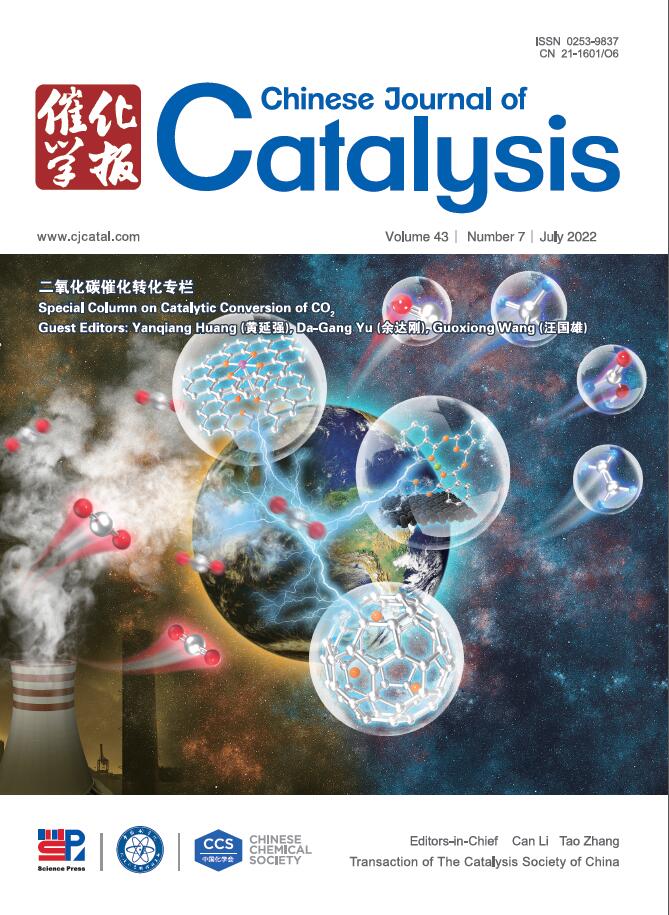甲烷制醇的光催化、电催化和光电催化转化
IF 15.7
1区 化学
Q1 CHEMISTRY, APPLIED
引用次数: 0
摘要
将温室气体甲烷转化为增值化学品,如酒精,是缓解环境问题和能源危机的一项有前途的技术。特别是甲烷在环境条件下的可持续光催化、电催化和光电催化转化被认为是替代热催化的一种替代技术。本文综述了光催化、电催化和光电催化转化甲烷制醇的最新进展。首先介绍了光催化、电催化和光电催化的一般原理。然后,我们详细讨论了光催化、电催化和光电催化甲烷氧化过程中,金属、无机半导体、有机半导体和异质结复合体系中C-H键的选择性活化及其氧化机制。随后,我们从带结构和活性位点的角度介绍了甲烷转化为醇的有效光催化剂、电催化剂和光电催化剂的构建。最后,对光催化、电催化和光电催化甲烷氧化系统的未来设计提出了挑战和展望。本文章由计算机程序翻译,如有差异,请以英文原文为准。
Photocatalytic, electrocatalytic and photoelectrocatalytic conversion of methane to alcohol
The conversion of the greenhouse gas methane to value-added chemicals such as alcohols is a promising technology to mitigate environmental issue and the energy crisis. Especially, the sustainable photocatalytic, electrocatalytic and photoelectrocatalytic conversion of methane at ambient conditions is regarded as an alternative technology to replace with thermocatalysis. In this review, we summarize recent advances in photocatalytic, electrocatalytic and photoelectrocatalytic conversion of methane into alcohols. We firstly introduce the general principles of photocatalysis, electrocatalysis and photoelectrocatalysis. Then, we discuss the mechanism for selective activation of C-H bond and following oxygenation over metal, inorganic semiconductor, organic semiconductor, and heterojunction composite systems in the photocatalytic, electrocatalytic and photoelectrocatalytic methane oxidation in detail. Later, we present insights into the construction of effective photocatalyst, electrocatalyst and photoelectrocatalyst for methane conversion into alcohols from the perspective of band structures and active sites. Finally, the challenges and outlook for future designs of photocatalytic, electrocatalytic and photoelectrocatalytic methane oxidation systems are also proposed.
求助全文
通过发布文献求助,成功后即可免费获取论文全文。
去求助
来源期刊

Chinese Journal of Catalysis
工程技术-工程:化工
CiteScore
25.80
自引率
10.30%
发文量
235
审稿时长
1.2 months
期刊介绍:
The journal covers a broad scope, encompassing new trends in catalysis for applications in energy production, environmental protection, and the preparation of materials, petroleum chemicals, and fine chemicals. It explores the scientific foundation for preparing and activating catalysts of commercial interest, emphasizing representative models.The focus includes spectroscopic methods for structural characterization, especially in situ techniques, as well as new theoretical methods with practical impact in catalysis and catalytic reactions.The journal delves into the relationship between homogeneous and heterogeneous catalysis and includes theoretical studies on the structure and reactivity of catalysts.Additionally, contributions on photocatalysis, biocatalysis, surface science, and catalysis-related chemical kinetics are welcomed.
 求助内容:
求助内容: 应助结果提醒方式:
应助结果提醒方式:


